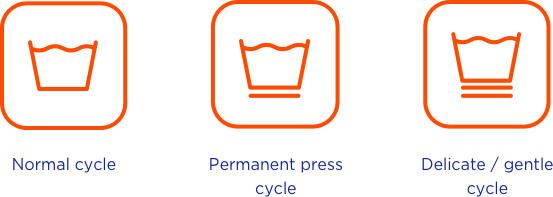
Laundry symbols seem like another language, but the washing machine symbols on your garments’ care labels tell you exactly how to do the washing and drying as well as give extra information on bleaching and ironing. Read on for our quick guide to what these wash symbols mean or download and print your own washing symbols chart to refer to when you see washing symbols on clothes you don’t recognize.
Getting the temperature and wash cycle right is important for seeing great laundry results and can even prevent damage to your clothes. Understanding the clothes washing symbols below can give you an idea for temperature, indicated by the number of dots in the tub of water symbol, whereas different cycle types are represented by a tub with one or two lines drawn under it. Of course, you’ll want to sort your clothing by type and color so that you’re using the appropriate wash cycle for each garment.
When looking at the wash symbols, the three-sided cup shape is meant to represent your washing machine tub, and these indicate what types of washing are safe for each particular garment.

Machine Wash: This symbol indicates it is safe to wash the garment in a machine using the temperature and cycle indicated by other symbols.
Hand Wash: The hand wash laundry symbol means you should not wash the garment in a machine and instead wash it by hand. Typically, this symbol applies to delicate garments made from fabrics like silk or linen. It may be safe to machine wash on a “hand wash” cycle setting if your machine has one, but care should be taken to protect the garment. You can also try putting the garment in a mesh bag or washing it alone to further protect it. If your garment is precious, vintage, or otherwise irreplaceable, take it to a professional cleaner.
Do Not Wash: Garments or fabrics with this laundry symbol should not be washed in a machine or tub but should be taken to a professional dry cleaner when they become dirty.
Dry Clean Only: Dry clean only garments must be taken to a dry cleaner for removal of dirt or other stains.
Do Not Dry Clean: Clothing with the do not dry clean symbol should be washed using the gentlest setting on your washer. This will minimize agitation and potential damage to the fabric. You can also place inside a mesh bag or turn the garment inside out, running it on a short, delicate cycle to clean.
Washing your clothing in the proper temperature water can affect how clean garments get during the wash as well as control wear and tear on the fabric. Not all fabrics are created equally, and some are more delicate than others, so understanding your clothes washing symbols and the proper temperature water to use when washing your clothes will get them as clean as possible while also ensuring they last longer.
![]()
Cold Temperature Water: Clothes with this symbol (wash tub with a single dot) should be washed in cold water between 65°F and 85°F.
Warm Temperature Water: Clothes with this symbol (wash tub with two dots) should be washed in warm water with a max temperature of 105°F.
Hot Temperature Water: Clothes with this symbol (wash tub with three dots) should be washed in hot water with a max temperature of 120°F.
Once you’ve determined that your garment is safe for machine washing and you know what temperature water to wash it in, it’s time to decide on what wash cycle to use. While many modern washing machines come with a wide variety of cycle settings, the washing machine symbols are quite straightforward, represented by a wash tub icon with either zero, one, or two lines underneath.

Normal Cycle: This wash cycle symbol is simply a tub with water in it and no lines underneath. It is reserved for stronger, more durable garments like t-shirts, socks, or jeans that can simply be tossed in and washed. These cycles typically provide more agitation and work harder to remove dirt and grime.
Permanent Press Cycle: This wash cycle symbol is a tub with water and a single line underneath. “Permanent Press” clothing is usually made from synthetic fibers like polyester that are specially treated to guard against wrinkles. The Permanent Press cycle uses warmer water and slower spin cycles to release and reduce existing wrinkles.
Delicate Cycle: This wash cycle symbol is a tub with water and two lines underneath. These cycles are meant for more delicate garments that could be prone to damage and uses low agitation, slow spin, and colder temperature water to wash clothes and protect fabric.
Important: Don't forget to look out for dry clean signs indicated by a circle, or hand wash symbols indicated by a tub of water with a hand sign, so you'll know when to avoid putting garments in the washing machine.
Drying is an important part of the clothing care process, but we’ve all heard those scary stories of cashmere sweaters that come out of the wash three sizes too small.
Knowing your clothing tag symbols—like the square with a circle in the middle that indicates tumble drying allowed—can help you avoid putting the wrong garment in the tumble dryer. Other symbols can give you additional information, such as a square with a horizontal line in the middle means you should dry the item flat, or the crossed-out twisted symbol, which tells you not to wring the garment. The temperature is given by the increasing number of dots inside a circle.
When it comes to doing your laundry, the drying process is every bit as important as the washing. Using the incorrect dryer setting could result in shrinking or permanent damage that can render your clothes unwearable. Knowing your drying symbols will be invaluable to you and save your favorite clothes from harm.

Tumble Drying Allowed: Any garment with the Tumble Drying Allowed symbol can go into your dryer, but pay special attention to any additional symbols that indicate appropriate heat settings or risk damage to your clothing.
Do Not Tumble Dry: This symbol, a standard Tumble Dryer symbol with an “X” through it, means the garment should not be put into your dryer at all. Instead, opt to hang these on a clothesline or drying rack to dry. You could also put these garments through an extra spin cycle to remove as much excess water as possible before hanging to dry.
Hang to Dry: Items with the Hang to Dry symbol should be put on a line to allow them to air dry. Be sure to hang in a shady area out of direct sunlight as the sunlight can introduce heat that could shrink or damage the garment while drying.
Dry Flat: Clothing with the Dry Flat symbol shouldn’t be put into a tumble dryer or hung, but rather you should lay them flat on a drying rack or soft towel. Clothing made from natural fibers such as cotton, wool, silk, hemp, or linen usually need to be air dried while laying flat to avoid stretching the fibers.
Do Not Wring: Represented by a twisted symbol with an “X” through it, garments with this symbol should not be wrung to remove excess water as this could damage or stretch the fabric.